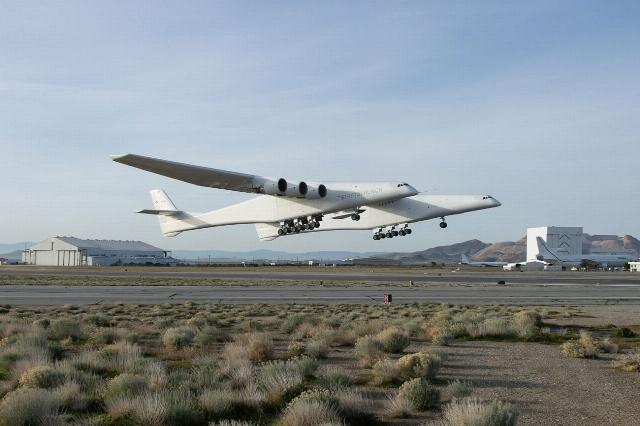The American company Stratolaunch has announced the successful completion of flight tests of a prototype of the Talon-A hypersonic vehicle equipped with a rocket engine. During the unmanned flight, the glider developed supersonic speed.
More than 10 years ago, Microsoft co-founder Paul Allen founded the aerospace company Stratolaunch . It was supposed to provide services for the delivery of goods into space using the air launch aerospace system. For this purpose, in 2017, a two-body Scaled Composites Model 351 (Stratolaunch Roc) aircraft with six engines and a wingspan of 117 meters was built. The aircraft was supposed to launch Pegasus X orbital rockets, as well as missiles of its own design.
However, after Allen's death in 2018, Stratolaunch was sold to the private equity firm Cerebus, and its concept changed. Now, instead of orbital launches, the company has focused on developing a reusable hypersonic glider capable of reaching speeds five times faster than sound (M = 5 ( Mach number ), or 6150 kilometers per hour).
The Talon-A ("Claw") glider project was first presented to the public in 2021. The length of the device was 8.5 meters, the wingspan was 3.4 meters, and the launch weight was almost three tons. It will be able to make long-term flights at high speeds and carry a payload. It is planned that the device can be launched in two ways: "air launch" — from under the wing of the Scaled Composites Model 351 carrier aircraft at a cruising altitude of 10 thousand meters (the aircraft will be able to carry three Talon-A devices at a time), or it will be able to take off independently from the runway.
In 2022, Stratolaunch conducted flight tests of the first prototype TA-0, attached to a pylon under the central section of the wing of the carrier aircraft. A year later, the prototype TA-0 was dropped from the wing for the first time. During the test flight, the device was without an engine. The test was successful and confirmed the possibility of safely separating the hypersonic glider from the aerial launch platform.
The other day, unmanned tests of the second prototype took place, but with a liquid-fueled Hadley rocket engine. The main tasks of the TA-1 test flight, which took place over the Pacific Ocean, were to perform a safe launch of the ship from the wing of the carrier aircraft, engine ignition, acceleration, steady climb and controlled landing on water.
Stratolaunch executives told reporters that they were satisfied with the flight, as all its goals were successfully achieved. For example, the Hadley engine worked out the planned time — about 200 seconds.
However, the company refused to disclose details about the maximum speed and altitude of the TA-1 flight, citing a "non-disclosure clause" in a document signed with unidentified customers. They only noted that the device had developed a supersonic speed close to hypersonic.
The prototype of the TA-1 hypersonic glider is disposable. The third prototype, the TA-2, will already be reusable, it will be able to land on the runway. Flight tests of this machine are scheduled for the second half of 2024. In addition, another prototype, the TA-3, is also reusable, is under construction. The company is also working on the creation of a larger Talon-Z hypersonic vehicle, which will be able to reach speeds up to M = 10 (10,620 kilometers per hour).
Talon-A hypersonic gliders will be equipped with a Hadley liquid engine developed by the private American aerospace company Ursa Major Technologies. It uses rocket kerosene and liquid oxygen as fuel. The thrust of the engine is five thousand pounds (2,268 kilograms-force).
What exactly Stratolaunch is developing a hypersonic glider for is not completely clear. The relevant websites write that the device "will provide wide access to hypersonic tests, will be a reliable test bed for hypersonic research and experiments, and with its help it will be possible to quickly carry out any missions."
In addition, it is said that Talon-A will provide customers with the opportunity to receive the necessary information in real time. On-board instruments will be able to collect fundamental aerothermal data, which will then be used to compare and calibrate forecasting tools. The glider will also be able to carry a secret payload, which after the flight "can be extracted and analyzed."
Potential customers of Stratolaunch include the US Department of Defense, commercial organizations and research institutes. The company has already signed several contracts with the US Air Force Research Laboratory and the Navy, under which it is planned to conduct five Talon-A tests in the interests of the US military.
It should be noted that the Talon-A hypersonic glider, developed by the private American aerospace company Stratolaunch, is not the first of its kind. France has a similar device, but it is intended only for military purposes.
In 2023, the French first tested a guided hypersonic combat glider called the V-MAX. The press release stated that the device "contains many on-board technological innovations" and will be able to reach speeds of more than six thousand kilometers per hour. Its main use is quick and unexpected strikes on the enemy. At the same time, it is noted that intercepting the V-MAX is a very difficult task: it will be able to overcome all promising missile defense systems with high efficiency.

